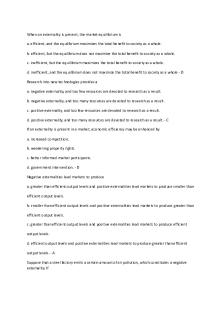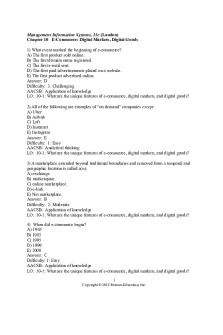Econ 2100 chap 10 PDF

| Title | Econ 2100 chap 10 |
|---|---|
| Course | Microeconomics |
| Institution | British Columbia Institute of Technology |
| Pages | 3 |
| File Size | 35.4 KB |
| File Type | |
| Total Downloads | 59 |
| Total Views | 150 |
Summary
Econ 2100 chap 10...
Description
When an externality is present, the market equilibrium is a. efficient, and the equilibrium maximizes the total benefit to society as a whole. b. efficient, but the equilibrium does not maximize the total benefit to society as a whole. c. inefficient, but the equilibrium maximizes the total benefit to society as a whole. d. inefficient, and the equilibrium does not maximize the total benefit to society as a whole - D Research into new technologies provides a a. negative externality, and too few resources are devoted to research as a result. b. negative externality, and too many resources are devoted to research as a result. c. positive externality, and too few resources are devoted to research as a result. d. positive externality, and too many resources are devoted to research as a result. - C If an externality is present in a market, economic efficiency may be enhanced by a. increased competition. b. weakening property rights. c. better informed market participants. d. government intervention. - D Negative externalities lead markets to produce a. greater than efficient output levels and positive externalities lead markets to produce smaller than efficient output levels. b. smaller than efficient output levels and positive externalities lead markets to produce greater than efficient output levels. c. greater than efficient output levels and positive externalities lead markets to produce efficient output levels. d. efficient output levels and positive externalities lead markets to produce greater than efficient output levels. - A Suppose that a steel factory emits a certain amount of air pollution, which constitutes a negative externality. If
the market does not internalize the externality, a. the supply curve would adequately reflect the marginal social cost of production. b. consumers will be required to pay a higher price for steel than they would have if the externality were internalized. c. the market equilibrium quantity will not be the socially optimal quantity. d. producers will produce less steel than they otherwise would if the externality were internalized. - C Suppose that cookie producers create a positive externality equal to $2 per dozen. What is the relationship between the equilibrium quantity and the socially optimal quantity of cookies to be produced? a. They are equal. b. The equilibrium quantity is greater than the socially optimal quantity. c. The equilibrium quantity is less than the socially optimal quantity. d. There is not enough information to answer the question. - C Suppose that smoking creates a negative externality. If the government does not interfere in the cigarette market, then a. the equilibrium quantity of cigarettes smoked will equal the socially optimal quantity of cigarettes smoked. b. the equilibrium quantity of cigarettes smoked will be greater than the socially optimal quantity of cigarettes smoked. c. the equilibrium quantity of cigarettes smoked will be less than the socially optimal quantity of cigarettes smoked. d. There is not enough information to answer the question. - B Suppose planting flowering shrubs creates a positive externality equal to $7 per shrub. Further suppose that the local government offers a $7 per-shrub subsidy to planters. The number of shrubs that are planted is then
a. less than the socially optimal quantity. b. greater than the socially optimal quantity. c. equal to the socially optimal quantity. d. There is not enough information to answer the question - C In many cases selling pollution permits is a better method for reducing pollution than imposing a corrective tax because a. it is hard to estimate the market demand curve and thus charge the "right" corrective tax. b. selling pollution permits create a net increase in pollution. c. Corrective taxes distort incentives. d. Corrective taxes provide greater flexibility to firms that can reduce pollution at a low cost. - A...
Similar Free PDFs

Econ 2100 chap 10
- 3 Pages

Econ 2100 Test Review
- 4 Pages

Micro Econ 2100 Exam 2
- 14 Pages

Sta-2100-notes - Lecture notes 1-10
- 71 Pages

Chap 10. economics
- 15 Pages

chap 10 testbank
- 24 Pages

10 Quiz ECON 502 - quiz 10
- 5 Pages

Ch 10 - econ 1000 ch 10 notes
- 8 Pages

HDFS 2100 - Chapter 9
- 6 Pages

Marketing research testbank Chap 10
- 13 Pages

Econ - econ
- 1 Pages

COMM 2100 - Exam 2 Review
- 20 Pages
Popular Institutions
- Tinajero National High School - Annex
- Politeknik Caltex Riau
- Yokohama City University
- SGT University
- University of Al-Qadisiyah
- Divine Word College of Vigan
- Techniek College Rotterdam
- Universidade de Santiago
- Universiti Teknologi MARA Cawangan Johor Kampus Pasir Gudang
- Poltekkes Kemenkes Yogyakarta
- Baguio City National High School
- Colegio san marcos
- preparatoria uno
- Centro de Bachillerato Tecnológico Industrial y de Servicios No. 107
- Dalian Maritime University
- Quang Trung Secondary School
- Colegio Tecnológico en Informática
- Corporación Regional de Educación Superior
- Grupo CEDVA
- Dar Al Uloom University
- Centro de Estudios Preuniversitarios de la Universidad Nacional de Ingeniería
- 上智大学
- Aakash International School, Nuna Majara
- San Felipe Neri Catholic School
- Kang Chiao International School - New Taipei City
- Misamis Occidental National High School
- Institución Educativa Escuela Normal Juan Ladrilleros
- Kolehiyo ng Pantukan
- Batanes State College
- Instituto Continental
- Sekolah Menengah Kejuruan Kesehatan Kaltara (Tarakan)
- Colegio de La Inmaculada Concepcion - Cebu



